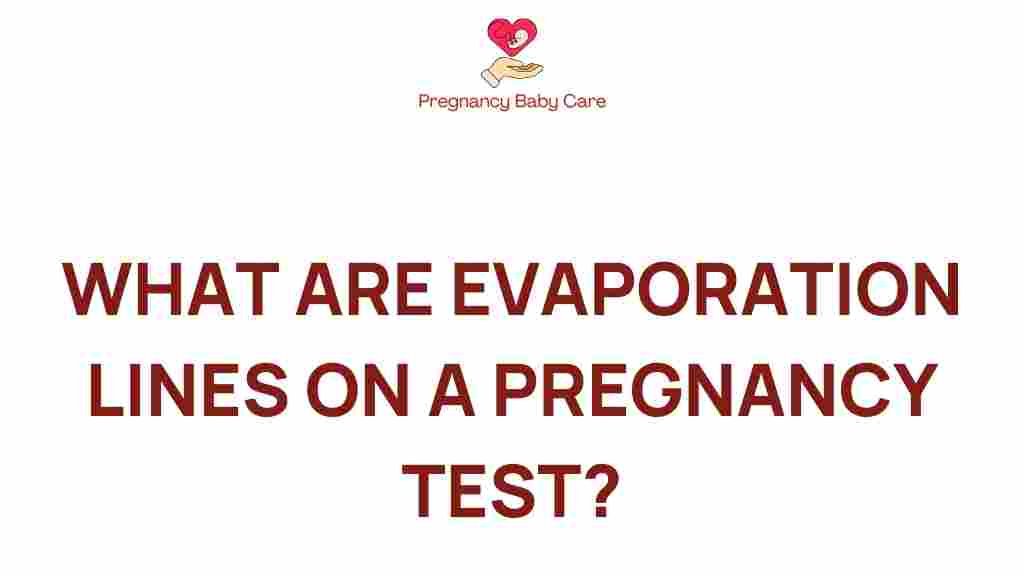Unraveling the Mystery: What Are Evaporation Lines on a Pregnancy Test?
When it comes to home pregnancy tests, many women experience a mix of excitement and anxiety. The quest for understanding whether a pregnancy test indicates a positive result can often lead to confusion, especially when it comes to interpreting the results. One of the most common sources of misunderstanding is the presence of evaporation lines. In this article, we will delve into what evaporation lines are, how they can affect test accuracy, and what you need to know to avoid false positives. Understanding these concepts can help you make informed decisions about your reproductive health.
What Are Evaporation Lines?
Evaporation lines appear as a faint line on a pregnancy test after the urine has dried. They are caused by the evaporation of the liquid in the test, which can leave behind a residue that looks like a second line. These lines can often be misleading, leading many to question whether they are experiencing early signs of pregnancy.
How Do Pregnancy Tests Work?
Before we dive deeper into evaporation lines, it’s essential to understand how pregnancy tests function:
- HCG Detection: Most home pregnancy tests work by detecting the hormone human chorionic gonadotropin (HCG), which is produced shortly after a fertilized egg implants in the uterus.
- Test Types: There are two main types of tests: urine tests and blood tests. Home tests are typically urine tests, providing results within minutes.
- Timing: For the most accurate results, tests should be taken after a missed period, as HCG levels are higher at that point.
Understanding Test Accuracy
The accuracy of a pregnancy test can be influenced by various factors:
- Timing: Testing too early can lead to inaccurate results. It’s best to wait until after your missed period for the most reliable outcome.
- Test Sensitivity: Different brands of tests have varying sensitivities to HCG. Some tests can detect lower levels of HCG than others.
- Follow Instructions: Not following the test instructions can lead to incorrect results.
Evaporation Lines vs. Positive Results
One of the biggest challenges is distinguishing between an evaporation line and a positive result. Here are key differences:
- Time Frame: Evaporation lines typically appear after the recommended reading time, while a positive result should be read within the specified time frame.
- Color and Darkness: Positive lines are often darker than evaporation lines and have a more vivid color.
- Location: Evaporation lines may appear in the test area but not in the control area, while positive lines will appear in the designated test line area.
When to Take a Pregnancy Test
If you suspect you might be pregnant, consider the following:
- Missed Period: The best time to take a test is after you’ve missed your period.
- Pregnancy Symptoms: Symptoms such as nausea, fatigue, and breast tenderness can indicate pregnancy, but they are not definitive.
- Morning Testing: Taking the test with your first morning urine can yield more accurate results due to higher concentrations of HCG.
Step-by-Step Guide to Home Testing
To ensure you get the most accurate results from a pregnancy test, follow these steps:
- Choose the Right Test: Select a high-quality pregnancy test known for its reliability.
- Check Expiration Date: Ensure the test is not expired, as this can affect accuracy.
- Read Instructions: Carefully follow the instructions provided with the test.
- Test Timing: Wait until at least one day after your expected period for the best results.
- Collect Sample: Collect urine in a clean cup or directly on the test strip, as instructed.
- Wait for Results: Do not exceed the time limit indicated on the package to avoid confusion with evaporation lines.
Troubleshooting Common Issues
If you find yourself confused about the results of your pregnancy test, here are some troubleshooting tips:
- Re-Test: If unsure, wait a few days and test again. HCG levels double approximately every 48 hours in early pregnancy.
- Consult a Doctor: If you receive a positive result or are experiencing pregnancy symptoms, schedule a visit with your healthcare provider for confirmation.
- Consider Blood Tests: For more accurate results, a blood test can be performed at a doctor’s office.
What to Do if You Get a False Positive
False positives can occur, and understanding why is crucial:
- Chemical Pregnancy: This occurs when a fertilized egg does not implant properly, leading to a temporary rise in HCG levels.
- Medications: Certain fertility medications containing HCG can cause false positives.
- Errors in Testing: Not following the instructions or using expired tests can also lead to inaccurate results.
If you suspect you have received a false positive, it’s important to confirm the result with a healthcare professional. They can provide guidance and further testing options.
Understanding Reproductive Health
Understanding how pregnancy tests work, including the significance of evaporation lines and the potential for false positives, is essential for maintaining good reproductive health. Being informed helps you make better decisions and reduces anxiety during the testing process.
For more information on reproductive health and pregnancy testing, check out this comprehensive guide.
Conclusion
In conclusion, evaporation lines on a pregnancy test can be a source of confusion and anxiety for many women. By understanding what they are, how pregnancy tests work, and how to interpret results accurately, you can navigate the challenging landscape of home testing with confidence. Remember to follow the instructions carefully, consider timing, and consult a healthcare provider if you have any questions or concerns about your results.
Being informed about pregnancy symptoms, the accuracy of tests, and the possibility of false positives will empower you in your journey towards understanding your reproductive health. With the right knowledge, you can avoid the pitfalls of misinterpreting evaporation lines and focus on what truly matters: your health and well-being.
This article is in the category Pregnancy and created by PregnancyBabyCare Team
